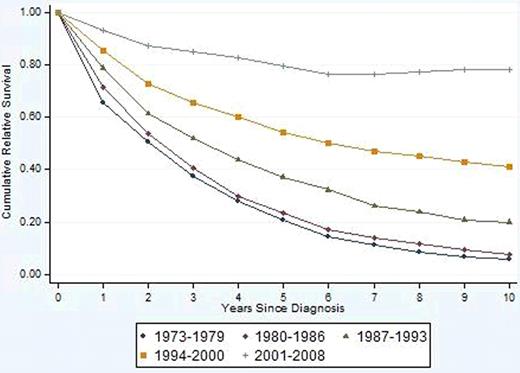Abstract
Abstract 205
Little progress in terms of improving survival in patients with chronic myeloid leukemia (CML) was made until the introduction of interferon alpha and allogeneic stem cell transplantation for selected patients in the 1980s. The management changed dramatically with the development of imatinib mesylate, the first tyrosine kinase inhibitor (TKI) that targets the BCR-ABL1 oncoprotein. In Sweden clinical trials started in December 2000 and the drug was approved for clinical use in November 2001.
This study evaluates the impact of treatment developments in CML by studying temporal trends in short-term and long-term excess mortality in a population-based setting.
Using data from the nationwide, population-based Swedish Cancer Registry and Swedish population life-tables stratified by age, sex, and calendar time we characterized trends in relative survival for all patients diagnosed with CML in Sweden 1973–2008 (n=3,173; 1,796 men and 1,377 women; median age 62 years). Patients were categorized into five age groups (<50, 50–59, 60–69, 70–79 and >79 years) and five calendar periods (1973-1979, 1980–1986, 1987–1993, 1994–2000 and 2001–2008). Six hundred and nine stem cell transplants (539 allogeneic and 70 autologous) were reported to the EBMT registry during the study period.
Incidence remained stable over time with a consistent male predominance. Relative survival improved with calendar period with the greatest improvement in the last two calendar periods (figure). Five-year cumulative relative survival ratios (RSRs; 95% confidence intervals) were 0.21 (0.17-0.24), 0.23 (0.20-0.27), 0.37 (0.33-0.41), 0.54 (0.50-0.58) and 0.80 (0.75-0.83) in the five calendar periods, respectively. Ten-year RSRs were 0.06 (0.04-0.08) and 0.78 (0.73-0.83) in the first and last calendar periods, respectively. This improvement was confined to age groups up to 79 years of age but most pronounced in patients below 60 years. The 5-year RSRs for patients diagnosed 2001–2008 were 0.91 (0.85-0.94), 0.87 (0.78-0.92), 0.82 (0.72-0.90), 0.75 (0.61-0.86), and 0.25 (0.10-0.47) for the five age groups, respectively. Older age at diagnosis and male sex were associated with significantly higher excess mortality rates in models adjusted for potential confounding factors.
In this large population-based study including > 3,000 CML patients survival increased significantly after 2001 (when imatinib mesylate was approved for clinical use in Sweden) for patients up to 79 years of age. Future studies are needed to assess if very old (>79 years) CML patients may benefit from an increased use of TKIs. Also newly introduced, targeted treatment options for CML need to be evaluated in future population-based studies.
No relevant conflicts of interest to declare.
Author notes
Asterisk with author names denotes non-ASH members.


This feature is available to Subscribers Only
Sign In or Create an Account Close Modal